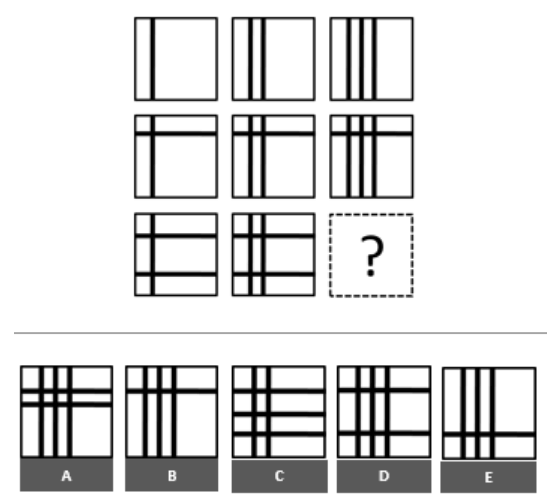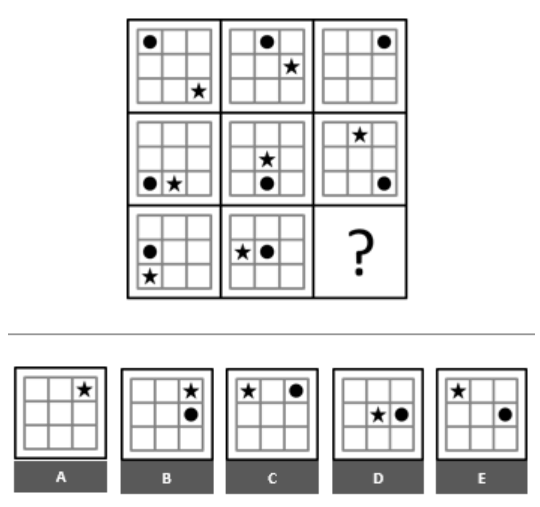This is a complete guide to the CCAT spatial reasoning questions (also named abstract reasoning) where we will review:
- The three question types that will appear on your test
- Sample CCAT spatial reasoning questions that resemble the actual test
- Full explanations and valuable tips for each question type
For more CCAT questions and free sample questions for the other sections, check out one of the options below:
What Spatial Reasoning Questions to Expect on the CCAT?
There are 11 spatial reasoning questions on the CCAT, which makes this portion third in size (after the CCAT math and verbal questions).
Potential employers want to evaluate your spatial reasoning since it's directly related to problem-solving ability and critical thinking, which are essential skills in almost any job.
Abstract reasoning questions are usually what CCAT test-takers struggle with the most because it's an ability you rarely practice in your daily life.
Additionally, since you have only 15 minutes to complete the CCAT exam, you'll need to solve some questions in as little as 18 seconds per question, making these questions even more nerve-racking.
To help you get a feel for this portion, we'll review each question type appearing on the test and provide examples with explanations and tips (taken from our CCAT prep course).
Next in Series
There are four 'Next in Series' questions on the CCAT. In each question, you are given five figures which form a series that follows a specific rule.
Your task is determining which figure matches the pattern and continues the series.
Try the following two practice questions to understand the concept better:
Practice Questions
Question #1

Which of the following boxes should replace the three dots (...) to complete the pattern?
Answer & Explanation
The correct answer is the middle figure.
The black circle moves in alternating ways. The first way it moves is from the bottom corner of the grid to the top corner of the grid on the same side.
The second move is from one corner in the grid to the opposing one. The white square moves clockwise, increasing its step by one between diagrams. Hence at first, it will move one block clockwise, then it will move two blocks clockwise, and so forth.
Question #2

Which of the following boxes should replace the three dots (...) to complete the pattern?
Answer & Explanation
The correct answer is the second from the left.
The series is made up of pairs. The first and second frames are a pair, the third and fourth frames are a pair, and thus the fifth frame and the missing frame are a pair.
When moving from the first diagram in each pair to the second diagram, the outer shape becomes the inner shape and changes color to black, and the inner shape becomes the outer shape without changing its color.
Following this logic, the diamond in the last diagram should change color to black and become the inner shape in the missing diagram. The inner triangle should become the outer shape while maintaining its color.
Tips for Next in Series Questions
- To answer the question, start with forming a hypothesis by looking at two or three frames. Identifying how the objects change from one frame to another is the basis of the assumption. Once you've made an assumption, you must check if it applies to the entire sequence.
- If your assumption is correct, quickly go over the distractors and eliminate them.
- If you cannot form a pattern, go straight to the answer choices. Often, 1-2 answers will be far off the correct answer, and you'll be able to eliminate them immediately. In addition, it's usually enough to identify the rotation of only one object in the frame (for example, only the inner figure in sample question 2) to eliminate 1-2 more answer choices.
Odd One Out
There are four 'Odd One Out' questions on the CCAT. In each question, you are given five different figures. Your task is to determine which of the figures doesn’t match the characteristics of the other four. This figure will be the odd one out.
Practice Questions
Question #1
Which of the following does not belong?

Answer & Explanation
All answer options except for (E), present six stars, while answer-option (E) presents five stars.
Therefore, option E is the correct answer.
Question #2
Which of the following does not belong?

Answer & Explanation
Answer-option (C) has two white squares and one black square while the rest of the answer options have two black squares and one white square.
Therefore, option C is the correct answer.
Tips for Odd One Out Questions
- Start counting: count how many shapes are there in each frame. Are they even or uneven? Does the increase or decrease gradually?
- Colors and shading: look at the colors of the shapes (both inner and outer figures).
- Rotation: check if the figures rotate clockwise or counterclockwise. See if all figures rotate in one direction while only one turns in the other direction.
Matrices
There are three matrix questions on the CCAT. First, you will be presented with an incomplete 3x3 matrix of symbols. Your task is to identify the missing symbol from five alternatives.
The symbols have no meaning, but all matrices follow a logical sequence, across rows, across columns, or both. So the missing symbol should be the one that sticks to the logic of the matrix.
CCAT's matrices questions often look complex and challenging at first glance because of their overwhelming number of frames and figures. But with prior preparation, you'll be able to solve them in seconds. So, let's try two sample questions to start to get the hang of it:
Practice Questions
Question #1
Which of the following boxes below replace the question mark (?) to complete the pattern?

Answer & Explanation
The correct answer is D.
Across the rows, the number of vertical lines increases by one line. For example, in the first row, the first frame contains one vertical line, the second frame contains two vertical lines, and the third frame contains three vertical lines.
You can see the same pattern in the second and third rows. Therefore, the empty square in the third row will contain three vertical lines. Eliminate answer-option C, as it contains two vertical lines.
Down the columns, the number of horizontal lines increases by one line. Take a look at the first column. In the top frame, there aren't any horizontal lines, in the middle frame there is one horizontal line, and in the third frame, there are two horizontal lines.
The second and third columns will exhibit the same pattern. In the third column, the first frame does not contain any horizontal lines, the second frame contains one horizontal line, so the third frame will contain two horizontal lines.
Eliminate answer-options B and E as they do not contain two horizontal lines. Additionally, notice that the spacing between the horizontal lines is very large. You can eliminate answer-option A and are left with answer-option D.
Question #2
Which of the boxes below should replace the question mark (?) to complete the pattern?

Answer & Explanation
The correct answer is E.
In this matrix there are two rules:
The circle: Across a row (from left to right) the circle always remains in the same row but moves one column to the right in each successive frame. Down a column, in each frame, the circle is always in the same row but is in different columns.
The star: Across a row (from left to right) the star always remains in the same column but moves up one row in each successive frame. Down a column, the star always remains in the same row but moves 1 column to the left in each successive frame.
(In the upper-right frame the star and circle end up in the same position and the circle covers the star).
Eliminate the 1st answer-option because it is missing a circle. You can further eliminate the 2nd and 4th answer-options because the star is in the wrong position, and the 3rd answer-option because it has the circle in the wrong position.
Therefore, you are left with the 5th answer-option as the only correct answer.
Tips for Matrices Questions
- Start by quickly scanning the matrix, both the rows and the columns, to see if anything draws your attention.
- Most of CCAT's matrix questions will follow two or more of these rules:
(1) Progression - the object changes with every step throughout the row or the column (the direction may vary). The changes could be in the length or width of the shape, the number of objects inside the frame, the shape’s color, or any of its other characteristics.
(2) Rotation - the figures in the matrix rotate in a determined pattern across either rows or columns. You need to identify the rotation pattern to answer the question correctly.
(3) Motion - the objects move (change their position) with each step. Usually, the motion is of one or more objects inside a frame.
Continue Practicing for the CCAT Test
Keep practicing for the CCAT so that you take the test while being as prepared as possible and score high.
Try our 24-question free CCAT practice test and access the complete CCAT test prep course with six full-length simulations and dozens of extra practice drills (including verbal).




